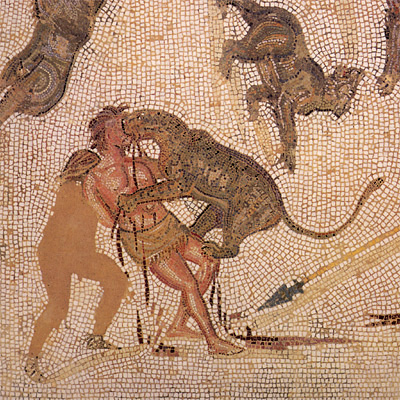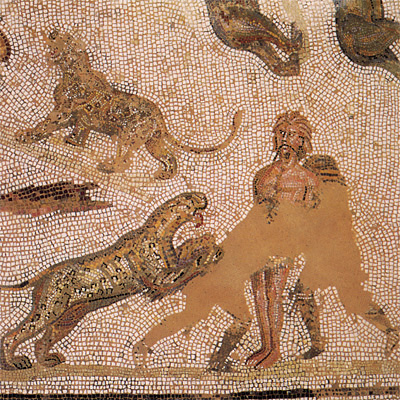
"Criminals destined for a fate without hope were nevertheless well fed in order to fatten the animals....A special effort had been made to bring these brave animals from abroad to serve as executioners for those condemned to death."
Apuleius, The Golden Ass (IV.13)

In these details from a third-century AD mosaic in the Museum of El Djem (Tunisia), criminals, themselves made beasts by their crimes, are offered up to wild animals in the arena. The images are similar to those of the Zliten mosaic, where the victims are wheeled in on small, chariot-like carts.
Christian martyrs often suffered the same fate. Saturus, the priest of Perpetua and Felicitas, who died with them in the Carthage arena in AD 203, first was bound to a wild boar, which turned instead upon the venator, mortally wounding him. He then was tied to a bridge and exposed to a bear, which refused to leave his cage. Finally, he was exposed to a leopard, whose bite bathed the hapless man in so much blood that the crowd, mocking baptism, taunted "Well washed! Well washed!" (Passio, XIX, XXI).
Elaborate sets were constructed. Strabo witnessed the death of a brigand who had raided the area around Mount Etna. "I saw him torn to pieces by wild beasts at an appointed combat of gladiators in the Forum; for he was placed on a lofty scaffold, as though on Aetna, and the scaffold was made suddenly to break up and collapse, and he himself was carried down with it into cages of wildbeasts—fragile cages that had been prepared beneath the scaffold for that purpose" (VI.2.6).
Martial tells of theatrical presentations based on mythological themes.
"Whatever Rhodope is said to have watched on Orpheus' stage, the arena Caesar, displayed to you. Rocks crept and a wondrous forest ran, such as the grove of the Hesperides is believed to have been. Every kind of wild beast was present, mingling with the tame, and many a bird hovered above the bard. But himself lay torn by an ungrateful bear. This thing alone was done contrary to the legend" (On the Spectacles, XXIV).
Eurydice presumably sends a bear because she wants Orpheus back with her in Hades. Or it may be that Orpheus was not able to charm the creature with his lyre. The story of Pasiphaë also was re-enacted. "Believe that Pasiphae was mated with the Dictaean bull; we have seen it, the old legend has won credence. And let not hoary antiquity plume itself, Caesar: whatever Fame sings of, the arena affords you" (VI). Suetonius relates that Nero also presented the myth on stage (Life, XII.2) and Apuleius contrives an even more elaborate account in the Metamorphoses (X).
References: Mosaics of Roman Africa: Floor Mosaics from Tunesia (1996) by Michèle Blanchard-Lemée, Mongi Ennaïfer, Hédi Slim, and Latifa Slim; The Acts of the Christian Martyrs (1972) by Herbert Musurillo; The Geography of Strabo (1929) translated by Horace L. Jones (Loeb Classical Library); Martial: Epigrams (1993) translated by D. R. Shackleton Bailey (Loeb Classical Library).